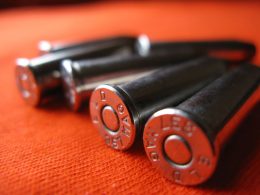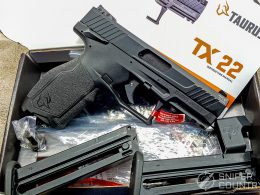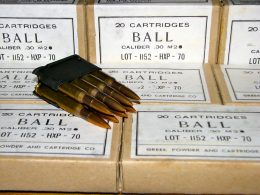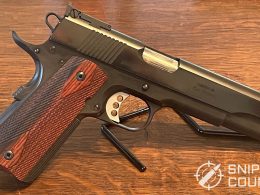There is a never-ending debate of which cartridge is better: the 9mm vs 45 ACP. Both rounds are popular within the firearms community, and you’ll often see this argument in forums and threads online. Of course, personal preferences play an essential role in determining which handgun is for you.
To help you make a decision we’ll talk about the advantage, disadvantages, specs, and features of the 9mm vs 45 ACP.
First, let’s discuss the differences and learn the disadvantages and advantages of the two cartridges over one another.
BONUS OFFER: Get your free shooting range targets to print at home!
Get your free targets to print at home!
9mm Specs
| Case Type | Rimless, tapered |
| Capacity | 0.3393 of an inch |
| Case Length | 0.754 of an inch |
| Weight | 115 to 147 grains |
| Bullet Diameter | 0.355 of an inch |
| Average Round Velocity | 1,200 feet per second (fps) |
.45 ACP Specs
| Case Type | Rimless, straight |
| Capacity | .6811 of an inch |
| Case Length | 0.898 of an inch |
| Weight | 165 to 230 grains |
| Bullet Diameter | 0.452 of an inch |
| Average Round Velocity | 830 feet per second (fps) |
9mm vs 45 ACP: Which One for Self-defense? Why the Caliber Matters
In shooting a firearm, selecting an ideal cartridge is vital. The gun owner’s proficiency in carrying and shooting the gun is also important. You need to know how to control the recoil to get accurate hits every single time. Additionally, you need to also consider the availability and legality of cartridges in your area.
Bullet Types
Both calibers may differ in various ways. However, both calibers come in the following cartridge types.
Full Metal Jacket
Full metal jackets (FMJs) are cartridges that have a soft, lead core encased in a metal shell. This type is excellent for use in target practice at the range as they are less likely to deform. In addition, FMJs hold trajectory well and have excellent penetration against soft tissue.
Hollow-point Bullets
Hollow-point bullets are often used for hunting as they expand on impact. Additionally, they don’t over-penetrate. Therefore, it causes bullet tears on the target. Additionally, its structure has a hollowed-out tip and centers, which causes the mushrooming or expansion of the bullet upon contact with soft tissue. A photo of the example of the expansion of the bullets is provided below. You can commonly find hollow point bullets on .45 ACP cartridges.
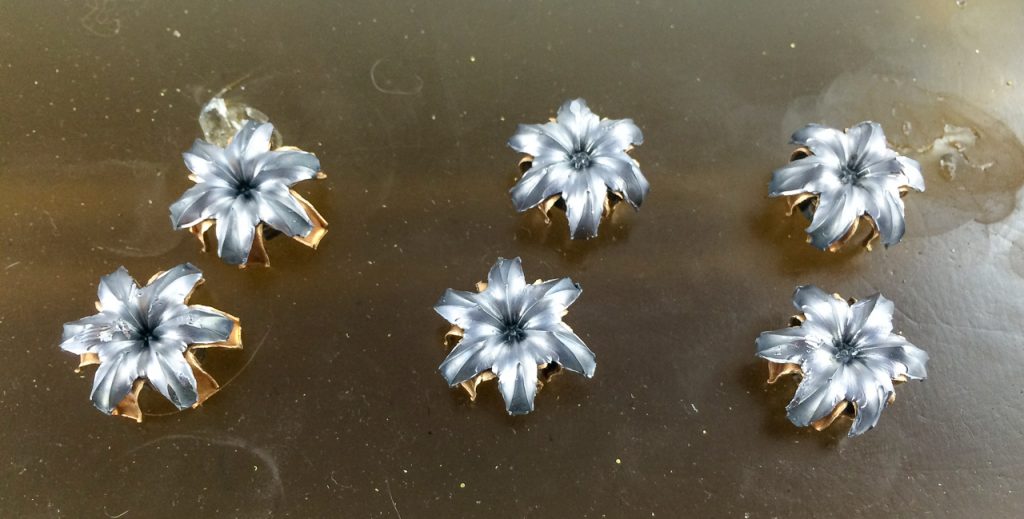
9mm vs .45 ACP Comparison Table
| 9mm | .45 ACP | |
|---|---|---|
| Synonyms/Other Names/ Variations | 9 mil, 9mm Luger, 9 x 19mm Parabellum, 9mm NATO | .45 Auto Rim, .45 Auto, .45 Colt, .45 Super |
| Bullet Diameter | 0.355 inches (9.01 mm) | .452 inches (11.5 mm) |
| Base Diameter | 0.391 of an inch | .476 of an inch |
| Case Type | Rimless, tapered | Rimless, straight |
| Magazine Capacity (Factory) | 6 to 20 rounds | 6 to 14 rounds |
| Maximum Pressure | 34,084 pounds per square inch (psi) [235 megapascals (MPa)] | 21,000 psi [140 MPa] |
| Muzzle Energy | 304 lb/ft [124 grains at 1,050 fps] | 369 lb/ft [230 grains at 850 fps] |
| Place of Origin | Germany | United States |
| Year Introduced | 1901 | 1904 |
| Designer | Georg Luger | John Browning |
Popular Articles
Quick History of the 9mm and .45 ACP
9mm History

In 1902 the DWM, Deutsche Waffen and Munitionfabriken introduced the 9mm. It was Georg Luger who originally designed the 9mm cartridge. He derived the round from an earlier design that is the 7.65x21mm Parabellum. This caliber was also derived from an earlier cartridge, the 7.65x25mm Borchardt, which was used in the Borchardt C-93 pistol.
In 1902, the 9mm was presented to the British Small Arms Committee. Then, in 1903, three prototypes were presented to the United States Army for testing. In 1904, the German Navy officially adopted the cartridge. Finally, in 1906, the German Army also adopted the cartridge.
Nowadays, police agencies and civilians use the 9mm for self-defense purposes. It is also currently the most popular handgun and submachine gun ammunition because of its low cost and availability.
The 9mm is a rimless, tapered cartridge. It is lightweight and small, enabling more bullet capacity. Using a 9mm is also useful in stressful situations as a large number of shots are often missed. Today, the 9mm is the standard cartridge for the NATO forces, including many non-NATO countries worldwide because of its easy handling and popularity as a cartridge for concealed carry weapons.
A great 9mm weapon is the Taurus G3c. You can read more about it in our Best 9mm Pistols, A Complete Guide.
.45 ACP History
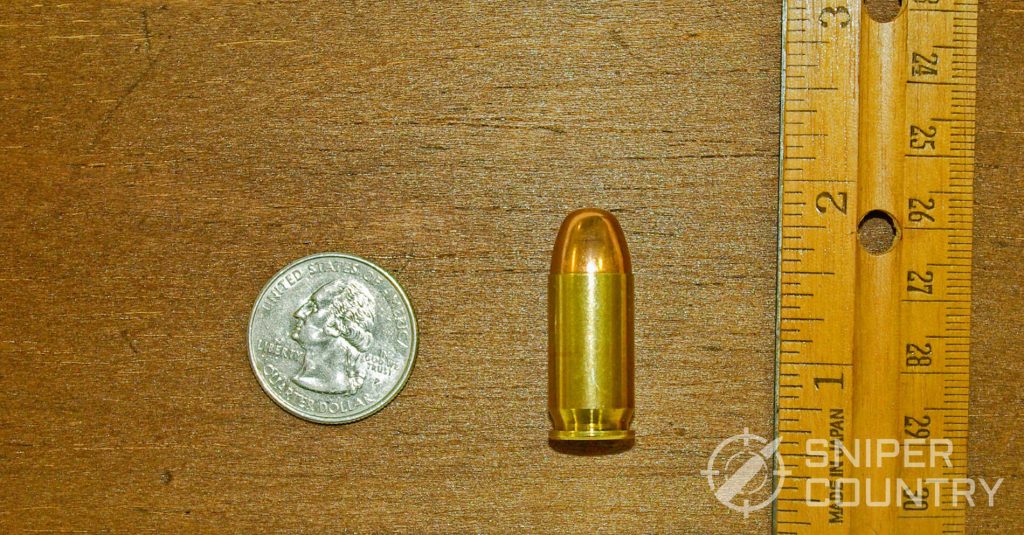
In 1904, the U.S. government asked Frankford Arsenal and the civilian industry to improve their existing pistol rounds. Winchester Repeating Arms words with Colt Manufacturing Co. to create the .45 ACP cartridge.
Afterward, in 1905, John Browning designed the prototype for a .45 ACP semi-automatic pistol. After successful trials, the .45 ACP was adopted as the standard chambering for the Colt M1911. In addition, the .45 caliber is continually praised for its stopping power.
In 1911, the M-1911 was introduced and became the weapon of choice for the U.S. Army, Navy, and the Marine Corps because of the caliber’s reliable stopping power.
The cartridge went through modifications and redesigns for further improvement until firearm manufacturers came up with the .45 ACP we are using today.
A fun .45 ACP pistol is the Rock River Arms BBR 3.10 .45 ACP. We also have the Best .45 ACP Pistols [Excluding 1911s] guide.
The 9mm vs 45 ACP: Complete Guide
Summary Table
| 9mm | .45 ACP | |
|---|---|---|
| Capacity | Higher ammo capacity; 6 to 20 rounds | Less bullet capacity; 6 to 14 rounds |
| Size and Weight | Smaller, lighter, and compact | Larger, heavier, and holds more gunpowder; more stopping power |
| Recoil | Less recoil | Comparably larger recoil |
| Penetration and Expansion | More penetration; less expansion; great for outdoor use | Less penetration; more expansion; good for indoor use |
| Cost and Availability | Affordable | More expensive |
| Velocity | Higher velocity | Less velocity due to bigger size |
| Power/ Ballistics | Has higher velocity and offers more penetration | Offers large expansion and more power |
| Suppressed | Effective noise reduction but decreases accuracy | Creates louder noise; accuracy isn't affected by suppressor |
| Stopping Power | Needs more shots to stop a threat | Has more knockdown power; takes fewer rounds to stop a threat |
Capacity
Some folks prefer larger bullets to more capacity. It seems that in the world of firearms, taking one advantage makes you give up another. However, this aspect is also according to the shooter’s preference.
Equipping yourself with a 9mm enables you to get a higher capacity. Its small bullet diameter makes this possible, enabling you to have six to 20 cartridges in the magazine. A .45 ACP, however, can give you six to 14 rounds.
Size and Weight

Image source: Quora
In the world of firearms, bullet size can determine shooting performance. Size can also give you an idea of the muzzle velocity, action on impact, and many other factors. In addition, size is also equal to the amount of gunpowder in a cartridge. Typically, a larger cartridge means more gunpowder, which is equal to more power once released from the chamber.
One way to determine the size and weight of a cartridge is through the unit called grains. The heavier the bullet, the more stopping power it contains.
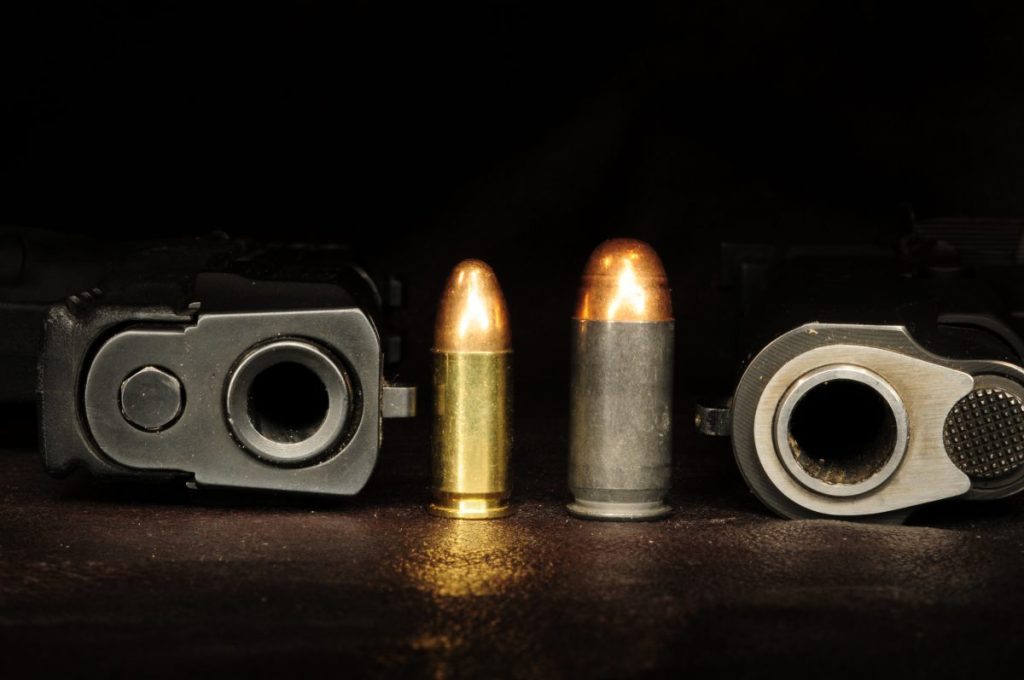
For our 9mm vs .45 ACP comparison, the 9mm is smaller and more compact and has less power. The .45 ACP is comparably larger, heavier, and wider. Therefore, it can hold more gunpowder and stopping power.
BONUS OFFER: Get your free shooting range targets to print at home!
Get your free targets to print at home!
Recoil
One important aspect in getting accurate shots is your ability to control the gun, especially if you’re firing shots consecutively. If you’re using a heavy or large bullet, aggressive recoil can disrupt your aim, causing you to miss the target.

Recoil is the way after you fire a gun, the gun pushes the spring in the chamber, causing the gun to recoil back toward you. Additionally, recoil energy can cause safety issues, especially if you are unaware.
Size is also a factor as larger bullets mean more recoil. In addition, recoil energy can cause safety issues if you’re unaware. If you have never handled a gun before, you might get surprised with recoil after firing a round. If you shot a 9mm, but never a .45 ACP, expect a larger push back.
The 9mm has quick and low recoil. Therefore, you can do easier follow-up shots using this round. However, shooting the .45 ACP delivers an aggressive recoil. It can have push-back energy of up to 10 pounds. Shooting a .45 requires practice and training to handle this round well.
Penetration and Expansion
Using a .45 ACP might lessen the risk of bullets going through walls. Hence, it’s a more preferred caliber for home defense. However, the 9mm may be more comfortable to use, but it might cause more damage indoors because of its penetration.
Cost and Availability

Generally, 9mm ammo is cheaper and more prominent than the .45 ACP. It is also the most economical pistol centerfire round available. So, if you’re looking for a budget-friendly option, the 9mm is a better choice.
Velocity
The general rule in firearms is that the higher velocity, the better the trajectory. It means that a bullet with higher velocity will go on a straight line farther distances than those with lower velocities. So, if you like long-range shooting, go for those with higher velocities.
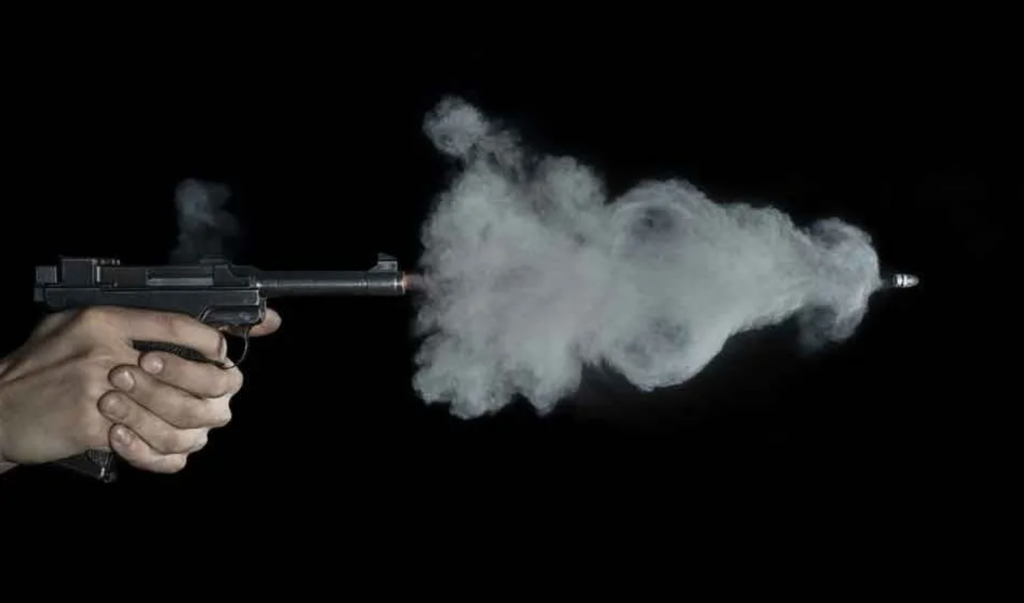
In addition, higher terminal performance is better for self-defense. In comparison, 9mm has higher velocity, with an average of 1,200 fps, it has little to no bullet drop in short to medium distances. It can also penetrate deeper.
The .45 ACP is slower than the 9mm, with an average velocity of 830 fps. Its bullet drop overshot distance is negligible. However, with its large diameter, it cannot deeply penetrate targets. But it has excellent stopping power.
Power/Ballistics

To name a few: the diameter, grain amount, and gunpowder level of the bullet define the characteristics of the cartridge and its impact. It may also include stopping power, penetration, and expansion. Additionally, a higher lb/ft of muzzle energy is equal to a more powerful bullet.

A 9mm is smaller and lighter compared to the .45 ACP. Therefore, it moves more quickly and has more penetration into the target. In addition to that, it also has higher velocity, giving more stopping power to halt the bullet. Meanwhile, the .45 ACP is a powerful bullet that offers large expansion upon impact because of its hollow-point design. Because of its heavier weight, it has less velocity. Thus, it won’t penetrate deeply. Additionally, it has 355 lb/ft which is a hefty amount of power since it can hold more gunpowder compared to the 9mm.
Suppressed

For those who like using suppressors, it is essential to take note that shooting a suppressed 9mm and .45 ACP is different. Most gun owners use a suppressor to minimize gunshot sounds, especially if other people are present. In addition, it may lower the sound, but it may also affect your accuracy. Moreover, it can also limit the abilities of your gun. For instance, due to added weight and decreased muzzle velocity.
However, using a suppressor may still produce loud sounds and may cause damage to the ears. Therefore, using ear protection is encouraged.
A suppressed 9mm can reduce the noise substantially than the .45 ACP. However, its accuracy is more affected by the suppressor. Using a suppressor in shooting a 9mm can significantly reduce accuracy. While .45 ACP cartridges can handle suppressors better than 9mm. They are comparatively larger, making them less prone to the effects of a suppressor. Using a suppressed .45 ACP retains the accuracy. However, it can also result in louder gunshot noises.
Stopping Power

The .45 ACP is often called the 9mm self-defense pistol for adults. However, that’s not always the case. The .45 ACP indeed has more stopping power — one of the reasons why the U.S. military adopted this cartridge with the 1911. In terms of knockdown power, the .45 ACP has the lead.
Wrap Up
The 9mm vs .45 ACP is a debate that is based on one’s preferences. The 9mm caliber is smaller and has more bullet capacity. It has less recoil, making it easy to handle, especially for beginners. It’s also faster and can penetrate deeper because of its lighter bullets.
Meanwhile, the .45 ACP caliber has outstanding stopping power and has more recoil. It has a smaller bullet capacity, and it’s typically slower because of its bigger and heavier bullets. It has a shallow penetration, which makes it an excellent gun for home defense.
So, if you find one cartridge more comfortable to shoot other than the other, then stick to using that cartridge. It’s best to find the ideal cartridge that you can shoot accurately.
If you prefer lighter and smaller but fast with deep bullet penetration, then the 9mm caliber is for you. Now, if you like something larger and more powerful but is slower and heavier — and needs a lot of practice, then the .45 ACP is your friend. Yes, the .45 ACP isn’t better than the 9mm or vice versa. Stop comparing, practice, and then you’ll find out which one works best for you.

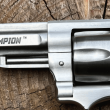



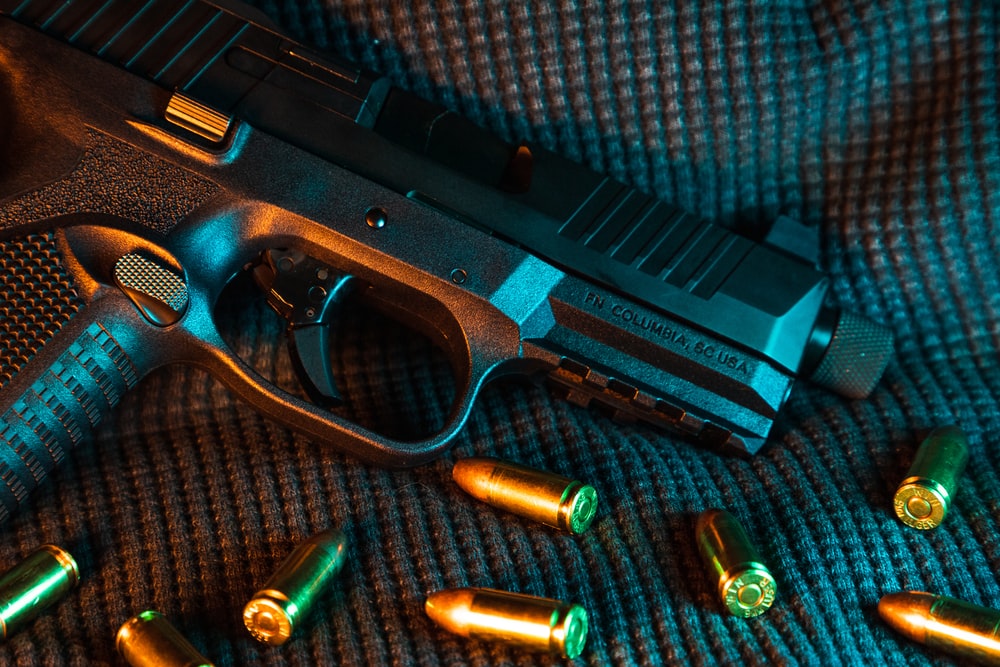
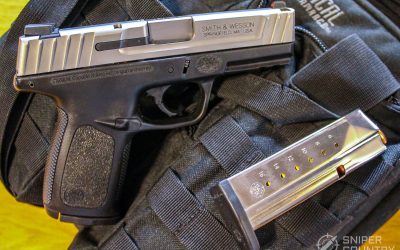

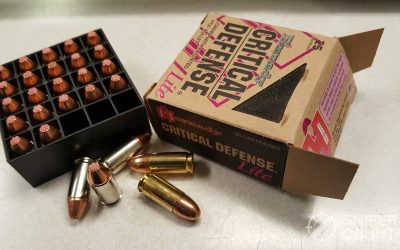
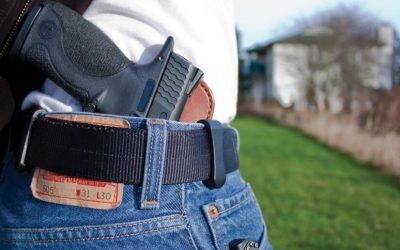
![9mm Glock Models [Ultimate Guide]](https://www.snipercountry.com/wp-content/uploads/2018/10/Glock-17-vs-Glock-19-vs-Glock-26-vs-Glock-41-vs-Glock-43-WM-400x250.jpg)
![Handgun Caliber Chart [2025 Ultimate Guide]](https://www.snipercountry.com/wp-content/uploads/2018/10/Handgun-Caliber-Comparison-400x250.jpg)
![Rifle Calibers [Ultimate Guide]](https://www.snipercountry.com/wp-content/uploads/2018/12/Header-1900-400x250.jpg)

